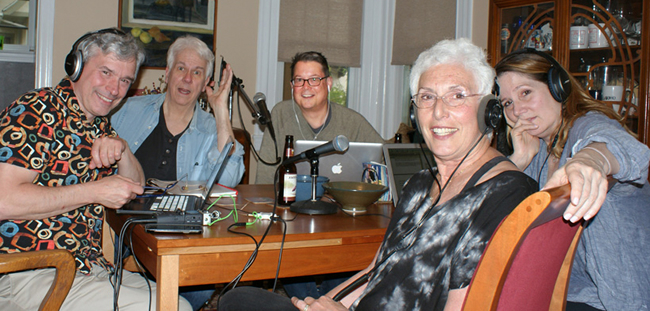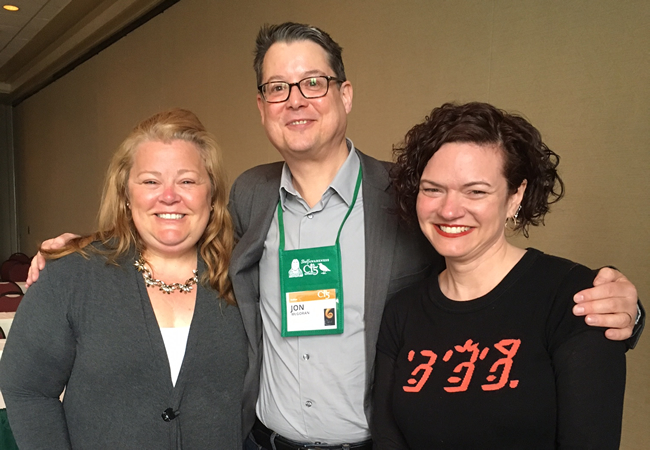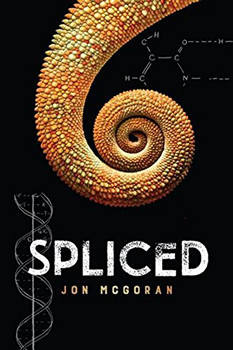A Hidden Agenda
In SPLICED, young people modify themselves by splicing animal genes into their own to become chimeras. When sixteen-year-old Jimi Corcoran’s best friend Del finally escapes his sadistic father, she is horrified to learn he has gone to get spliced. As Jimi plunges into the world of chimeras to save Del, the world erupts in a backlash against chimeras, and the group Humans for Humanity, or H4H, pushes through a new law that strips chimeras of their rights as human. As Jimi learns to respect, understand and even love the chimeras she meets, she also learns a terrifying truth: Those behind the backlash have a hidden agenda more hateful and horrific than anything she could have imagined.
With his first novel for teens, John McGoran delivers a chilling tale set in a near future with a science-fiction twist that is disturbingly all too real. New York Times bestselling author Joelle Charbonneau claims SPLICED is intense and provocative and “questions whether humanity is defined by our genetic make-up or our compassion.” In this cautionary tale, readers will also question on a whole new level what they believe about body modification and the social impact of technology.
McGoran’s other books include the acclaimed ecological thrillers Drift, Deadout, and Dust Up, as well as The Dead Ring, based on the hit TV show The Blacklist. Writing as D. H. Dublin, he is also the author of the forensic thrillers Body Trace, Blood Poison and Freezer Burn. When not writing novels and short fiction or co-hosting The Liars Club Oddcast, McGoran works as a freelance writer and developmental editor.
This month he spoke to The Big Thrill about the inspiration and research behind SPLICED.

Kirkus Reviews says SPLICED is “Timely, thrilling, and more than a little scary.” Why did you choose to write about DNA modification now and how close do you think our society is to your story becoming more fact than fiction?
I’m fascinated by all sorts of near future technologies, and how we are going to get from here and now to there and then. My last few books have been about biotech, and it was while researching them that I had the idea for SPLICED. I do think it is one of the more compelling and dynamic technologies, and one that, while it has already greatly impacted society, seems poised to change things even more. My last few books—Drift, Deadout and Dust Up—were science thrillers, whereas SPLICED is more a science fiction thriller.
I’ve thought a lot about the difference between those two subgenres, and in my mind, a big part of it is that in a science thriller, there is a central scientific element, but it takes place in our world, whereas in a science fiction thriller like SPLICED, the world is different, defined in part by the scientific elements. SPLICED takes place several decades in the future, so while some of the crazy science in the previous books came true or partially true within a year or two of publication, I think the technologies in SPLICED are still some time off. That said, there are definitely elements of the book that are already on the horizon.
In SPLICED, you’ve created a subculture of young people who splice themselves with animal genes. All your previous books have been written for adults. What inspired you to create this subculture with youth rather than adults?
Partly, I just wanted to write a young adult book. I love how the emotions are a little closer to the surface, and the characters, by definition, are in a more dynamic state than older adults. Plus, YA is more welcoming to playing with genre conventions. But also, the more I fleshed out the central idea for this book, the more I came to realize it made perfect sense that this would be a part of youth culture.
The term chimera comes from Greek mythology, an imaginary monster compounded of diverse types of species. The reality is that chimeras already exist amongst us through genetic modifications, correct? What spawned the idea for this terrifying story about biohacking?
That is true, there are all sorts of engineered chimeras, created by scientists to grow organs for transplant or to produce materials or substances (including a goat that has been spliced with spider DNA to create silk in its milk). I had read about biohacking while researching my earlier books, and I was both fascinated and frightened by the idea of people tinkering with genetic engineering in their garages—some more responsibly than others.
I knew I wanted to write about biohacking, and at first considered a story where things go wrong and something terrible escapes from the lab, etc. But then I had the idea of this biohacking subculture combining with the body modification subculture to form something entirely new. It was really intriguing to consider what that might look like given time to mature, socially and technologically, as well as how society might react to such a phenomenon. To me, that is the scariest aspect of the book: how non-chimera society reacts to the chimeras. Unfortunately, it’s not hard to see where those ideas came from.
Your main character, 16-year-old Jimi Corcoran, bravely plunges into the world of chimeras to prevent her best friend from getting spliced. Why did you choose a female for this role? And with your first teen protagonist, were there challenges in crafting Jimi?

There are challenges with every character, but yes, it was more challenging than if I was writing about a middle-aged male writer. A lot of thought went into the decision to make the main characters who they are. I knew the protagonist would be a teen, which would be a challenge in itself. I think part of being a writer is internalizing and remembering the things that you experience and the things that you see around you, and being able to draw from them.
Partly, I focused on remembering what my life was like as a teen, and who were my contemporaries, both male and female, and also thinking about the teens I know now, both male and female, and the similarities and differences—what seems to be universal versus what seems unique to a moment in time. I had written a female protagonist before, Madison Cross in the D. H. Dublin books, and it was a challenge, but I really enjoyed it and I thought it was successful.
As the basic plot elements came into focus, I thought it would be more interesting to have a female protagonist, and I liked the idea of writing a kickass female protagonist, and following her as she becomes so kickass. I think writing a protagonist who is different from you helps you step outside of yourself, it helps you question your preconceptions and assumptions. It also helps you stretch as a writer.
Altering one’s body through DNA modification takes body piercing to a whole new level. How did you incorporate the current notions of body modification today in SPLICED?
Body modification is kind of the jumping off point for getting spliced, and originally, I thought the similarities between today’s body modification and getting spliced would be stronger. But as I got into the book, and as I got into creating the world in which the book took place, I realized that for a lot of people, getting spliced would take on a different meaning than other forms of body modification. In many ways getting spliced is a statement about the world in which these teens live, so it ended up becoming much more of its own thing.
What kind of research fed into SPLICED? Did your research bring to light new areas of this revolutionary science for you that affected the story?

Many of the central ideas came from earlier research, so a lot of the basic research was done before I had the idea for the book, including ways viruses have been used as vectors in gene therapy. But this book isn’t about scientists developing these technologies, it is about young people using them long after they have been developed and been adapted to street use, so a lot of the technical research in that area, while important to the book’s underpinnings, isn’t really shown in the story.
There was plenty of other research as well. Climate change and energy issues and economics and epidemiology shape the world in which the book takes place, and implantable computers also figure prominently. All those things required substantial research of one sort or another, but they were also areas that I had previously researched for other projects, or for my own interest.
One thing I have found is that when looking a little further out into the future, the research tends to be more about reading, whereas when researching technologies that currently exist, or are just about to, it is much more helpful to find experts working on the specific technology in question, and more important, since you are trying to accurately depict things that already exist.
You raise many questions in SPLICED about undefined laws when it comes to new medical breakthroughs in genetics. How did your personal views thread into this story based on its scientific and political playing field?
Definitely, much of my writing is informed by the political and scientific observations of my life so far. In my previous books I have explored concerns about inadequate government oversight of the food, pharma and chemical industries, and increasing corporate influence on science, and those are areas I hope to continue to explore.
In SPLICED, I focus on other issues. Without a doubt, politicization of science and the ramifications of climate change and climate change-denial help shape the world in which SPLICED takes place, as do the unintended consequences of political decisions.
One of the most prominent themes, however, and one that I think is particularly relevant today, is how xenophobia and prejudice can drive politics and can be exploited for political gain, and also how the laws that are created to further those impulses are often not only morally reprehensible, but ill conceived, poorly crafted, and fortunately, often ultimately unworkable.
In SPLICED you also raise questions about what it means to be human, specifically: do genetics define us or does compassion? How did you decide to walk the line between this dilemma?
I think the whole question of what defines humanity or personhood is fascinating, and one that will have to be grappled with as technology forces the issue on a practical level – especially if and when true AI becomes a reality.
A lot of very talented writers are exploring trans-humanism or post-humanism and how the boundaries of what is considered human could be pushed through genetic or machine enhancements, both of which figure into SPLICED.
In researching the book, I read about the animal personhood movement, which people are often dismissive about because they don’t understand it. The argument is not that all animals are people, but rather that animals aren’t inanimate objects, either. A dog is different from a brick, and so mistreating a dog is different from mistreating a brick. Living things are different and deserve a certain legal standing. It is an idea that is gaining legal traction, and I think part of an increasingly nuanced understanding of the fluidity and ambiguity of boundaries and definitions that were once accepted as stark and rigid. In defining personhood, my strong feeling would be to embrace the broadest reasonable definition. Anything less feeds into humanity’s worst impulses.
SPLICED speaks to the very relevant prejudice today against people who modify their bodies from piercing to skin implants to gender reassignment surgery. How did this timely backlash fit into your story?
It can be very tricky when an idea serves as both a metaphor and an essential story element. In my writing, I try to always put story first, because I believe strongly that whatever you are writing about, whatever themes or issues you are grappling with, if the story doesn’t make sense, if it is not engaging, no one is going to care about any of that other stuff. If people don’t feel compelled to read the story, they aren’t going to get the point of your metaphor. In my mind, metaphor by definition is imperfect.
In the example you give, I would draw a pretty stark delineation between piercings or implants, which may be important elements of self image or self identification but are essentially choices, and gender reassignment, which is generally considered to be more a matter of reconciling one’s physical body with their innate gender identity. But I do think that many of the distinctions that were traditionally considered cut and dried, like race and sexual identity, are increasingly being recognized as more nuanced.
 Recent research suggests that the boundaries between species are not as clear-cut as once thought, either. The exchange of genetic material between very different species is much more common than previously thought, so I think the idea of chimeras does work as a metaphor for many things.
Recent research suggests that the boundaries between species are not as clear-cut as once thought, either. The exchange of genetic material between very different species is much more common than previously thought, so I think the idea of chimeras does work as a metaphor for many things.
But getting spliced isn’t just a metaphor: in the world of this book, people decide to become chimeras for specific, individual reasons. It has been pointed out, and rightly so, that in SPLICED the people are making a choice to become chimeras, and while, in our world, people can surely be persecuted because of choices they make, more often they are persecuted based on racial designation or gender or sexuality.
So, while I think being a chimera in this book works as a metaphor on many levels, ultimately, as often happens, the literal implications come into conflict with the metaphorical. That is one of the limits of metaphor, or at least this one.
Will Jimi’s story continue in a sequel to SPLICED or can we expect some new terrifying science-technology based tale from you?
Both! I have a couple of projects on the go, but I’m very excited to report that I am currently working on two more books in the SPLICED series.
*****
Jon McGoran is the author of SPLICED, a near-future YA science fiction thriller that Kirkus calls “Timely, thrilling, and more than a little scary.” McGoran’s other books include the acclaimed ecological thrillers Drift, Deadout, and Dust Up, as well as The Dead Ring, based on the hit TV show The Blacklist. Writing as D. H. Dublin, he is also the author of the forensic thrillers Body Trace, Blood Poison and Freezer Burn. When not writing novels and short fiction or cohosting The Liars Club Oddcast, McGoran works as a freelance writer and developmental editor.
To learn more, please visit his website.

